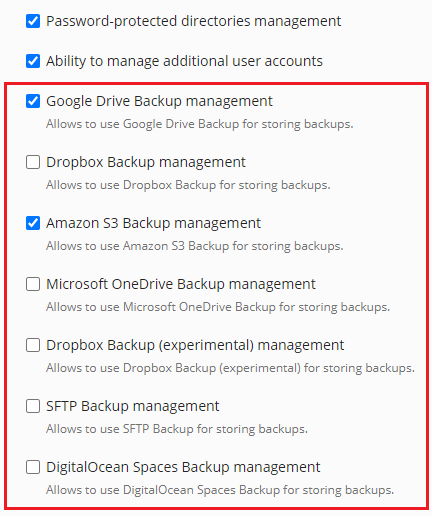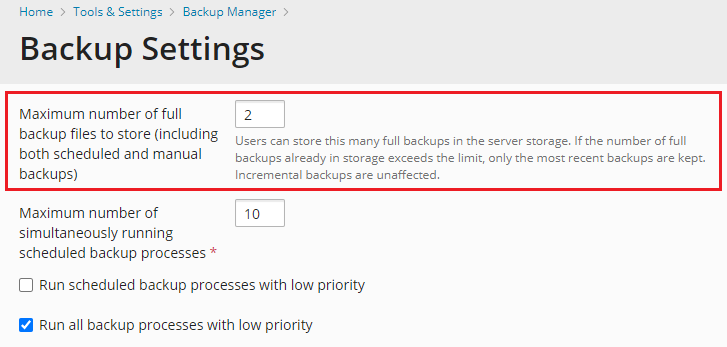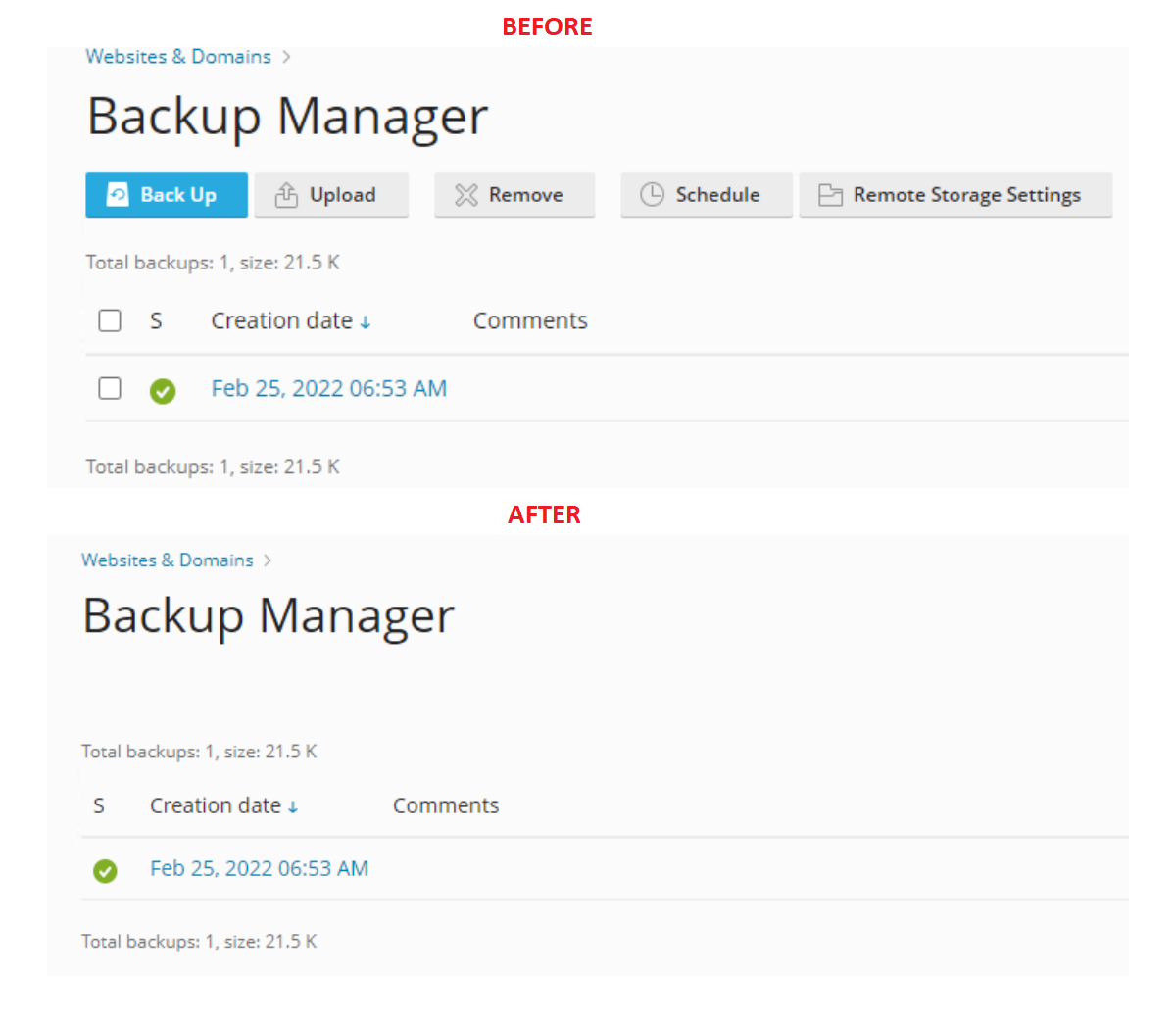Global Backup Settings
summary: Backup processes consume server resources and disk space, which may cause the performance of hosted websites to degrade. You can use a number of backup-related settings to control how much resources backup processes are allowed to consume, and also to limit the ability of customers and resellers to create backups both in server and remote storage.
In this topic, you will learn how to limit the amount of resources backup processes are allowed to consume, how to manage the encryption of Plesk backups serverwide, and also how to prevent customers and resellers from being able to create backups either in cloud storage, or at all.
If you serve numerous websites, you may want to configure the backup process so that it does not consume much server resources.
To configure server-wide backup settings:
-
Go to Tools & Settings > Backup Manager (under “Tools & Resources”) > Settings.
-
(Optional) In the corresponding field, specify the maximum number of full backups files (including both scheduled and manual backups) that can be stored in any type of storage.
For details, see “Backup Rotation”.
-
In the corresponding field, specify the maximum number of simultaneously running scheduled backup processes. The default value is 10.
-
To make the backup processes release resources to other server processes, “Run all backup processes with low priority” is selected by default.
You can choose to run only scheduled backups with low priority by selecting the corresponding checkbox.
Note: Both options increase backup time. Other server tasks will not work slower during backing up.
-
Set the desired compression level from the “Compression level” menu (“Fast” is used by default). Choosing a slower option reduces the size of backup files, but leads to higher CPU usage and longer backup times, while choosing a faster option leads to the opposite result (more disk space usage, less CPU usage, faster backups). This setting affects all backups made on the Plesk server.
Note: Plesk uses the Zstandard data compression algorithm. When the “Fastest” compression mode is selected, the value of the “compression level” argument used with the
pzstdcommand is set to “3”. Similarly, for the “Fast” mode it is set to “5”, for the “Normal” to “11”, and for the “Maximum” to “19”. -
To prevent backing up processes from consuming all available disk space on the server, “Start the backup only if your server has the sufficient amount of free disk space” is selected by default.
This option significantly increases backup time because Plesk additionally calculates the size of the future backup.
If you know the approximate size of the future backup and do not want Plesk to waste time and resources on calculating it, clear the “Start the backup only if your server has the sufficient amount of free disk space” checkbox. Instead, in “Start the backup only if your server has the specified amount of free disk space”, specify the approximate size of the future backup in megabytes.
Note: Plesk for Windows does not directly calculate object sizes but takes them from the database. As object sizes in the Plesk database are updated only once a day, the overall calculated backup size can differ from its real value.
-
Select whether to allow setting up FTP backup storage on the local Plesk server.
Users can configure their FTP storage to be located on the same Plesk server where their subscriptions are hosted. If they do so, the amount of used disk space will double upon creation of each backup. This can cause the server to eventually run out of free disk space. To prevent this, we recommend that you do not select the “Allow setting up FTP backup storage on the local server” checkbox.
-
Choose whether to save backups in the server storage if the upload to remote storage fails by selecting the corresponding checkbox.
Note: Backing up to the Plesk server storage is possible only for users with the “Backup and restoration of subscription data using the server storage” or “Backup and restoration of account data using the server storage” permissions.
-
Choose if you want to allow customers and resellers to schedule hourly backups by selecting the corresponding checkbox.
-
Click OK.
Backup Security Settings
You can select the type of protection for all Plesk backups stored in the server (local) repository:
-
Plesk’s encryption key. By default, certain sensitive data in a backup (for example, passwords of Plesk accounts) are encrypted with an internal key. The key is unique to each Plesk installation. Encrypting backups with Plesk keys is convenient but has certain limitations. When users restore backups created in other Plesk installations, the data is restored, but the original user passwords are lost, and new passwords are generated instead. In this case, the users will receive password change notifications by email. If you are going to restore a backup on another Plesk installation and want to avoid changing user passwords, use the Specified password option.
Note: The Plesk internal key encrypts only certain data in a backup but not the whole backup. If you store backups in remote cloud storage, you can enable backup encryption on the cloud storage side.
-
Specified password. You can specify a server-wide password to protect certain data in a backup. This type of protection is preferable and can be recommended in most cases. In particular, this may be useful in case of multiple Plesk installations, or if you store a backup on a mounted drive and use it for restoration if the drive with Plesk crashes. To restore all Plesk data including user passwords, you have to provide the same password that was specified for the backup.
The security settings described above are related to the backups stored in the server (local) repository only. If you are going to store a backup on an FTP server, please configure password protection in the FTP storage settings. For details, see Configuring Remote Storage.
Note: The passwords that subscription users might specify when downloading backups do not conflict with server-wide password or encryption key. For such backups, user-specified passwords are used. See Uploading and Downloading Backup Files.
Permissions for Storing Backups in Cloud Storage for Customers and Resellers
By default, once you install a cloud storage extension, your customers and resellers can also use it for storing their manual backups. To manage which cloud storage your customers and resellers are allowed to use, buy the Backup to Cloud Pro feature.
Once you bought the feature, you can allow or forbid your customers and resellers to use the installed cloud storage services on the “Permissions” tab (under “Show more available permissions”) when:
- Adding new or editing existing service plans and add-on plans.
- Customizing subscriptions.

The permission appears and becomes selected when the corresponding cloud storage extension is installed.
Changes in the permissions come info effect after sync.
Note: The “Backup and restoration of subscription data using remote storage” permission has priority over the permissions for storing backups in cloud storage. If “Backup and restoration of subscription data using remote storage” is not selected, customers and resellers cannot store backups in cloud storage even if the corresponding cloud permissions are selected.
Backup Rotation
To save disk space, you can set up a server-wide limit on the number of stored full backups in Tools & Settings > Backup Manager (under “Tools & Resources”) > Settings. When the limit is reached, Plesk irrevocably deletes the oldest backup files to free up space for new ones. We call this process backup rotation.
Note: The limit only affects full backups. The number of incremental backups is not limited.
Note: The limit affects the Plesk server local storage and any configured remote storage.

Backup rotation differentiates between manual and scheduled backups. If you have both manual and scheduled full backups whose number exceeds the limit, backup rotation deletes the oldest full backups in the following way:
- Keeps the latest manual backup.
- Keeps X-1 number of the latest scheduled backups, where X is the server-wide limit on the number of stored full backups.
- Deletes all other full backups.
For example, you have three manual backups and three scheduled backups. You set the server-wide limit on the number of stored full backups to three. After backup rotation, Plesk will keep the following full backups: the latest manual backup and the two latest scheduled ones.
Subscriptions, customers, and resellers have their own limits on the number of stored full backups in “Scheduled Backup Settings”. Setting up the server-wide limit changes the corresponding limits for new and existing subscriptions, customers, and resellers to match the server-wide limit value. It will be impossible to set the limits for subscriptions, customers, and resellers higher than the server-wide limit (see the screenshot below).

For example, a reseller has “Maximum number of full backup files to store” set to four. After you set the server-wide limit to two, the reseller’s limit will be automatically set to two to match the server-wide limit. The reseller will not be able to change their limit to the value higher than two.
Disabling Backup Management for Customers and Resellers
By default, customers and resellers can create, schedule, and delete backups. However, you as the Plesk administrator can disable backup management for them.
It can help to implement a backup policy consistent for all users and make sure that backups are regular and timely.
If you disable backup management for customers and resellers, they can no longer do the following:
- Create, schedule, and delete backups stored in Plesk or in remote storage.
- Access configured remote storage points or configure new ones.
- Upload backups.
Customers and resellers will be able to do only the following:
- Restore backups you create for them.
- Restore backups they created before (stored in Plesk or in remote storage).
Note: Scheduled backups configured before backup management is disabled will continue to be created on schedule.
To disable backup management for customers and resellers:
-
Open the panel.ini file for editing, which is located here:
- (Plesk for Linux)
/usr/local/psa/admin/conf/panel.ini - (Plesk for Windows)
%plesk_dir%admin\conf\panel.ini
You can also edit the file in the Plesk interface using the Panel.ini Editor extension.
- (Plesk for Linux)
-
Add the following lines to the
panel.inifile and save it:[pmm] manageBackupsByAdminOnly = true
You have disabled backup management for customers and resellers. Below you can see how this changes the Plesk interface for them.
